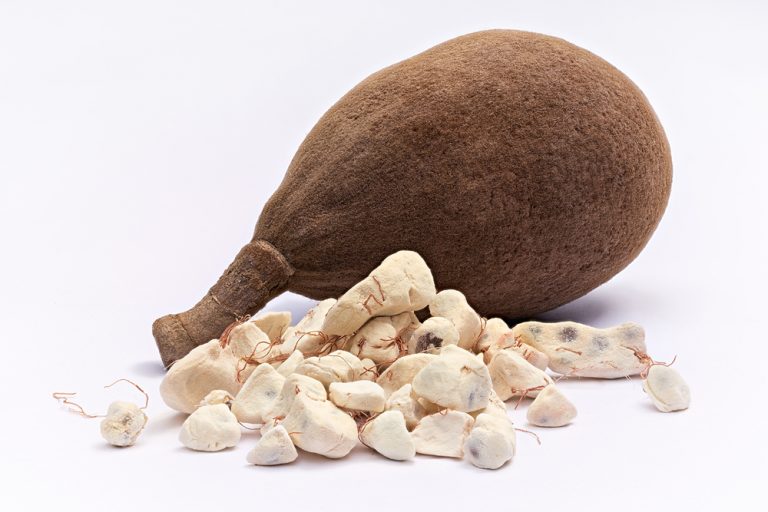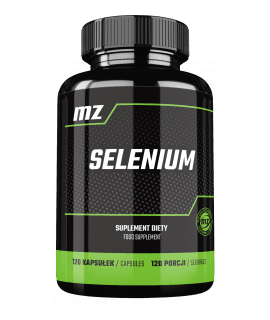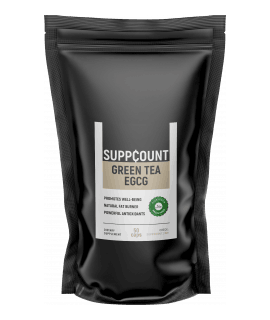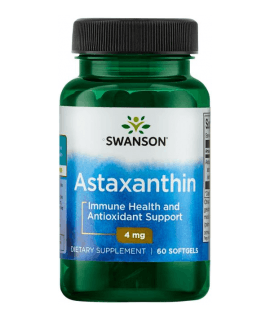Baobab is widely used by the indigenous people of Africa, also for medicinal purposes. Modern medicine confirms the antioxidant, anti-inflammatory and antibacterial properties of baobab fruit. Due to the very high concentration of vitamin C and its antioxidant potential, it was considered another superfood.
What is baobab?
Baobab (Adansonia digitala) is a huge tree that grows in the prairies and savannas in the Sahelian region of central Africa, as well as in the western part of Madagascar in very hot and dry areas. It grows up to 25 meters in height, and the trunk can be up to 10 meters in diameter. Baobab lives for several hundred years, and some sources say it can even get to 2000 years old.
Properties and nutritional value of baobab fruit
Baobab fruits are oblong in shape, 20-30 cm long and approx. 10 cm in diameter, which grow individually on long stalks. Baobab fruits are composed of a woody outer shell, which accounts for 45% of their weight, flesh (15%) and seeds (40%). Fresh fruit has a yellowish-white and slightly sour flesh inside, which in highly ripe fruits is naturally dehydrated, becomes loose and has the consistency of dense lumps of powder. The flesh surrounds numerous seeds and is divided into elements by red, filamentous fibres.
Vitamin C in baobab fruit
The baobab fruit provides mainly carbohydrates. They contain almost no water and no fat. They are a source of calcium, a large amount of potassium, thiamine, nicotinic acid and vitamin C in a very high concentration. Baobab is one of the best sources of vitamin C among fruit, but researchers note high variability in vitamin C content even among trees representing the same variety. The daily requirement for ascorbic acid can be covered by eating 23 g of powdered baobab.
Calcium in baobab fruit
The amount of calcium in baobab makes it a valuable part of the diet of people who do not consume milk and dairy products. The polyphenolic compounds present in the pulp are responsible for the high antioxidant potential of the baobab. Simple sugars constitute approx. 36% of all carbohydrates in the fruit, hence its clearly sweet taste. The flesh contains large amounts of pectin, mucilage as well as tartrates and tartaric acid, which are responsible for the sour taste. Baobab pectins have the ability to thicken liquid food, but they create irregular structures, which is why they are not used in industry.
Healing properties of baobab
Antioxidant activity
Baobab contains a lot of vitamin C (10 times more than oranges) and has a high antioxidant potential (nearly 40 times higher than oranges and 6 times higher than blueberries). Antioxidant compounds reduce the risk of damage to cellular structures and DNA, thus helping to prevent many diseases, including cancer and neurodegenerative diseases.
Anti-inflammatory activity
Baobab fruits reduce inflammation with comparable effectiveness to classic anti-inflammatory drugs. This activity is due to the presence of sterols, saponins and triterpenes. Therefore, baobab can be part of an anti-inflammatory diet.
A source of fibre
Baobab fruits contain a lot of soluble fibre (22.5% of the dry weight of the fruit) and insoluble (22% of the dry weight of the fruit). Scientific research has shown that baobab insoluble fibre is a great medium for the growth of health-beneficial probiotic bacteria from the Lactobacillus and Bifidobacterium species. Fibre also allows you to lower the glycaemic index of dishes. A small addition of powdered baobab to bread reduces the spike in blood sugar, which is important for people with insulin resistance and diabetes who need glycaemic control.









